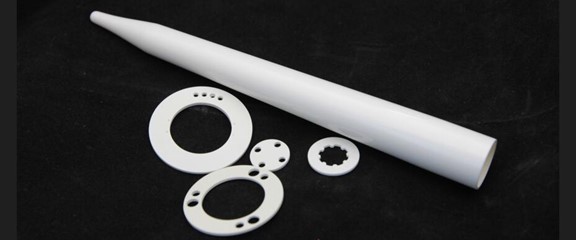Synthetic Routes to Obtain Hexagonal Boron Nitride Ceramic
Hexagonal boron nitride (h-BN), also known as white
graphite, is chemically and thermally stable and is a wide-band-gap
semiconductor. With its unique combination of properties such as low friction,
high thermal conductivity, excellent electrical insulation, and resistance to
oxidation, h-BN has gained considerable interest for various applications in
the fields of electronics, aerospace, and other advanced industries. In this
article, we will explore the synthetic routes to obtain hexagonal boron nitride
ceramic powder, which serves as the raw material for boron nitride ceramic, a
major product of QS Advanced Materials Inc.

Nitridation of Boron Oxide (B2O3)
Nitridation of boron oxide is another common method to
produce h-BN powder. In this process, boron oxide is mixed with a
nitrogen-containing compound, such as urea, melamine, or ammonium chloride, and
heated to high temperatures in an inert atmosphere. The nitrogen source reacts
with the boron oxide to form h-BN and by-products such as water, ammonia, or
hydrogen chloride.
The overall nitridation reaction using urea (CO(NH2)2) can be represented as:
Molten Salt Synthesis
Molten salt synthesis is an alternative approach to produce
h-BN powder. In this method, a mixture of boron oxide and a nitrogen source
(e.g., urea, melamine, or ammonium salts) is heated in a molten salt medium,
such as alkali metal halides (e.g., NaCl, KCl) or alkaline earth metal halides
(e.g., CaCl2). The molten salt serves as both a solvent and a heat transfer
medium, promoting the formation of h-BN at a lower temperature than in the
nitridation process.
The advantages of molten salt synthesis include lower reaction temperatures, shorter reaction times, and higher yields compared to the nitridation process. However, the method may introduce impurities from the molten salt medium, and the removal of the salt after the reaction can be challenging.
Polymer-Derived Ceramics (PDCs)
Polymer derived ceramics (PDCs) has been greatly developed
over the past 40 years, due to its advantages of simple operation, low
sintering temperature and strong design ability.Polymer-derived ceramics are
synthesized by pyrolysis of preceramic polymers containing boron and nitrogen
elements. Typically, borazine (B3N3H6) or its derivatives are used as the starting
materials. The polymers are heated to high temperatures in an inert atmosphere,
during which volatile by-products are released, and the remaining solid
transforms into h-BN.
Chemical Vapor Deposition (CVD)
Chemical vapor deposition is a popular method to synthesize
h-BN. With a graphite mold, it could directly obtain the desired shape of the
BN component. This type of boron nitride ceramic is also called pyrolytic boron
nitride (PBN). In this process, volatile precursors, typically boron and
nitrogen-containing gases, are introduced into a reaction chamber. The gases
react at high temperatures and deposit h-BN layers on a substrate. Products obtained
by this method The quality of the h-BN layers can be controlled by adjusting
the substrate temperature, gas flow rates, and chamber pressure.
The most common precursors used in the CVD process are
ammonia borane (NH3BH3), boron trichloride (BCl3), and ammonia (NH3). The
precursors decompose at high temperatures, releasing boron and nitrogen species
that react on the substrate surface to form h-BN. The overall reaction can be
represented as:
BCl3+ NH3→BN+HCl
CVD-based h-BN synthesis is advantageous due to its high
purity, scalability, and tunable thickness. However, it is also associated with
high equipment costs, complex processing parameters, and the potential for
environmental hazards due to the use of toxic precursors.

Conclusion
Multiple synthetic routes can be employed to obtain
hexagonal boron nitride ceramic powder, each with its advantages and
limitations. The choice of method depends on factors such as the desired
purity, particle size, and morphology of the h-BN powder, the scalability of
the process, and the cost and availabilityof the starting materials. Chemical
vapor deposition offers high purity and tunable thickness, but it is associated
with high equipment costs and the use of toxic precursors. Nitridation of boron
oxide is a relatively simple and cost-effective method but may result in impure
h-BN powder. Molten salt synthesis lowers the reaction temperature and time but
may introduce impurities from the salt medium. Lastly, polymer-derived ceramics
offer a high degree of control over the product's composition and structure but
are limited by the availability and cost of suitable preceramic polymers.
As the demand for h-BN and its derivatives continues to grow in various advanced industries, the development of more efficient, scalable, and environmentally friendly synthesis methods will be crucial. Researchers and companies like QS Advanced Materials Inc. are actively exploring novel synthesis routes and optimizing existing methods to meet the needs of the market.
